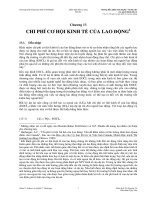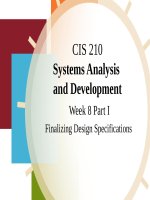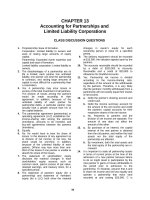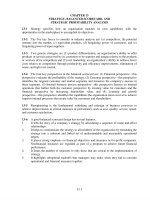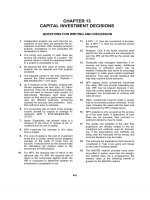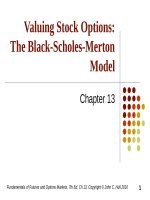Accounting26th ch 13
Bạn đang xem bản rút gọn của tài liệu. Xem và tải ngay bản đầy đủ của tài liệu tại đây (561.59 KB, 26 trang )
CHAPTER
13
Corporations: Organization,
Stock Transactions, and
Dividends
Warren
Reeve
Duchac
©2016
human/iStock/360/Getty Images
Accounting
26e
Advantages and Disadvantages
of the Corporate Form
©2016
Forming a Corporation
•
•
The first step in forming a corporation is to file an application
of incorporation with the state.
After the application has been approved, the state grants a
charter or articles of incorporation.
o
The articles of incorporation formally create the corporation.
• The corporate management and board of directors then
•
prepare a set of bylaws, which are the rules and procedures
for conducting the corporation’s affairs.
Costs incurred in organizing a corporation are debited to an
expense account entitled Organizational Expenses.
©2016
Stockholders’ Equity
(slide 1 of 4)
•
•
The owner’s equity in a corporation is called
stockholders’ equity, shareholders’ equity,
shareholders’ investment, or capital.
On the balance sheet, stockholders’ equity is reported
by its following two main sources:
o
o
Capital contributed to the corporation by the stockholders,
called paid-in capital or contributed capital.
Net income retained in the business, called retained
earnings.
©2016
Stockholders’ Equity
(slide 2 of 4)
•
The paid-in capital contributed by the stockholders is
recorded in separate accounts for each class of stock.
o
•
If there is only one class of stock, the account is entitled
Common Stock or Capital Stock.
Retained earnings is a corporation’s cumulative net
income that has not been distributed as dividends.
o
Dividends are distributions of a corporation’s earnings to
stockholders.
©2016
Stockholders’ Equity
(slide 3 of 4)
•
Net income increases retained earnings, while a net
loss and dividends decrease retained earnings.
o
The net increase or decrease in retained earnings for a
period is recorded by the following closing entries:
1. The balance of Income Summary (the net income or net loss) is
transferred to Retained Earnings.
– For net income, Income Summary is debited and Retained Earnings is
credited.
– For a net loss, Retained Earnings is debited and Income Summary is
credited.
2. The balance of the dividends account is transferred to Retained
Earnings.
– Retained Earnings is debited and Dividends is credited for the balance
of the dividends account.
©2016
Stockholders’ Equity
(slide 4 of 4)
•
•
Retained Earnings normally has a credit balance.
In some cases, a debit balance in Retained Earnings
may occur.
o
o
o
•
A debit balance in Retained Earnings is called a deficit.
Such a balance results from accumulated net losses.
In the Stockholders’ Equity section, a deficit is deducted
from paid-in capital in determining total stockholders’
equity.
The balance in Retained Earnings does not represent
surplus cash or cash left over for dividends.
©2016
Characteristics of Stock
(slide 1 of 2)
•
•
The number of shares of stock that a corporation is
authorized to issue is stated in its charter.
The term issued refers to the shares issued to the
stockholders.
o
•
•
A corporation may reacquire some of the stock that it has
issued.
The stock remaining in the hands of stockholders is
then called outstanding stock.
Shares of stock are often assigned a dollar amount,
called par value.
©2016
Characteristics of Stock
(slide 2 of 2)
•
•
•
Stock issued without par is called no-par stock.
Some state laws require corporations to maintain a
minimum amount of paid-in capital to protect
creditors. This minimum amount, called legal capital,
usually includes the par or stated value of the shares
issued.
The major rights that accompany ownership of a share
of stock are as follows:
o
o
o
The right to vote in matters concerning the corporation.
The right to share in distributions of earnings.
The right to share in assets upon liquidation.
©2016
Classes of Stock
(slide 1 of 2)
•
•
The two primary classes of paid-in capital are
common stock and preferred stock.
Preferred stockholders have first rights (preference) to
any dividends, and thus, they have a greater chance
of receiving dividends than common stockholders.
o
•
However, a corporation cannot guarantee dividends even
to preferred stockholders.
In addition to dividend preference, preferred stock
may be given preferences to assets if the corporation
goes out of business and is liquidated. However,
claims of creditors must be satisfied first.
©2016
Classes of Stock
(slide 2 of 2)
•
•
The payment of dividends is authorized by the
corporation’s board of directors. When authorized,
the directors are said to have declared a dividend.
Cumulative preferred stock has a right to receive
regular dividends that were not declared (paid) in
prior years. Cumulative preferred stock dividends that
have not been paid in prior years are said to be in
arrears. Any preferred dividends in arrears must be
paid before any common stock dividends are paid.
©2016
Issuing Stock
•
•
•
•
A separate account is used for recording the amount
of each class of stock issued to investors in a
corporation.
Stock is often issued by a corporation at a price other
than its par. The price at which stock is sold depends
on a variety of factors.
If the stock is issued (sold) for a price that is more than
its par, the stock has been sold at a premium.
If the stock is issued (sold) for a price that is less than
its par, the stock has been sold at a discount.
©2016
Premium on Stock
•
•
When stock is issued at a premium, Cash is debited
for the amount received. Common Stock or Preferred
Stock is credited for the par amount. An account
entitled Paid-In Capital in Excess of Par is credited
for the excess of the amount paid over par.
When stock is issued in exchange for assets other than
cash, such as land, buildings, and equipment, the
assets acquired are recorded at their fair market
value.
o
If this value cannot be determined, the fair market value of
the stock issued is used.
©2016
No-Par Stock
•
•
When no-par stock is issued, Cash is debited and
Common Stock is credited for the proceeds. As no-par
stock is issued over time, this entry is the same even if
the issuing price varies.
In some states, no-par stock may be assigned a stated
value per share.
o
The stated value is recorded like a par value. Any excess of
the proceeds over the stated value is credited to Paid-In
Capital in Excess of Stated Value.
©2016
Cash Dividends
(slide 1 of 2)
•
•
A cash distribution of earnings by a corporation to its
stockholders is a cash dividend.
Three conditions for a cash dividend are as follows:
o
o
o
•
Sufficient retained earnings
Sufficient cash
Formal action by the board of directors
There must be a sufficient (large enough) balance in
Retained Earnings to declare a cash dividend. That is ,
the balance of Retained Earnings must be large
enough so that the dividend does not create a debit
balance in the retained earnings account.
©2016
Cash Dividends
(slide 2 of 2)
•
Three dates included in a dividend announcement are
as follows:
1.
Date of declaration
The date of declaration is the date the board of directors formally
authorizes the payment of the dividend.
2.
Date of record
The date of record is the date the corporation uses to determine
which stockholders will receive the dividend.
3.
Date of payment
The date of payment is the date the corporation will pay the
dividend to the stockholders who owned the stock on the date of
record.
©2016
Stock Dividends
•
•
•
•
A stock dividend is a distribution of shares of stock to
stockholders.
Stock dividends normally are declared only on
common stock and issued to common stockholders.
A stock dividend does not change the assets,
liabilities, or total stockholders’ equity of a
corporation. It does not change an individual
stockholder’s proportionate interest (equity) in the
corporation.
A stock dividend affects only stockholders’ equity.
o
Specifically, the amount of the stock dividend is transferred
from Retained Earnings to Paid-In Capital.
©2016
Treasury Stock Transactions
(slide 1 of 2)
•
Treasury stock is stock that a corporation has issued
and then reacquired.
o
•
•
A corporation may reacquire (purchase) its own stock for a
variety of reasons.
The cost method is normally used for recording the
purchase and resale of treasury stock.
Using the cost method, Treasury Stock is debited for
the cost (purchase price) of the stock. When the stock
is resold, Treasury Stock is credited for its cost. Any
difference between the cost and the selling price is
debited or credited to Paid-In Capital from Sale of
Treasury Stock.
©2016
Treasury Stock Transactions
(slide 2 of 2)
•
•
A sale of treasury stock may result in a decrease in
paid-in capital. To the extent that Paid-In Capital
from Sale of Treasury Stock has a credit balance, it is
debited for any such decrease. Any remaining
decrease is then debited to the retained earnings
account.
No dividends (cash or stock) are paid on the shares of
treasury stock.
o
To do so would result in the corporation earning dividend
revenue from itself.
©2016
Stockholders’ Equity on the Balance Sheet
•
Two methods can be used for reporting stockholders’
equity on the balance sheet:
o
o
Method 1. Each class of stock is reported, followed by its
related paid-in capital accounts. Retained earnings is then
reported, followed by a deduction for treasury stock.
Method 2. The stock accounts are reported, followed by the
paid-in capital reported as a single item, Additional paid-in
capital. Retained earnings is then reported followed by a
deduction for treasury stock.
©2016
Reporting Retained Earnings
•
Changes to retained earnings may be reported using
one of the following:
o
o
o
Separate retained earnings statement
Combined income and retained earnings statement
Statement of stockholders’ equity
©2016
Restrictions
•
•
The use of retained earnings for payment of
dividends may be restricted by action of a
corporation’s board of directors.
Such restrictions, sometimes called appropriations,
remain part of the retained earnings.
o
•
These restrictions are usually disclosed in the notes to the
financial statements.
Restrictions of retained earnings are classified as
legal, contractual, or discretionary.
©2016
Prior Period Adjustments
•
•
The effect of errors that may arise from a
mathematical mistake or from a mistake in applying
accounting principles that are not discovered within
the same period in which they occur should not affect
the current period’s net income.
Instead, the correction of the error, called a prior
period adjustment, is reported in the retained
earnings statement as an adjustment to the beginning
balance of retained earnings.
©2016
Statement of Stockholders’ Equity
•
•
When the only change to stockholders’ equity is due
to net income or net loss and dividends, a retained
earnings statement is sufficient.
However, when a corporation also has changes in
stock and paid-in capital accounts, a statement of
stockholders’ equity is normally prepared.
©2016
Stock Splits
•
A stock split is a process by which a corporation
reduces the par or stated value of its common stock
and issues a proportionate number of additional
shares.
o
•
A stock split applies to all common shares including the
unissued, issued, and treasury shares.
A major objective of a stock split is to reduce the
market price per share of the stock.
o
This attracts more investors and broadens the types and
numbers of stockholders.
©2016



